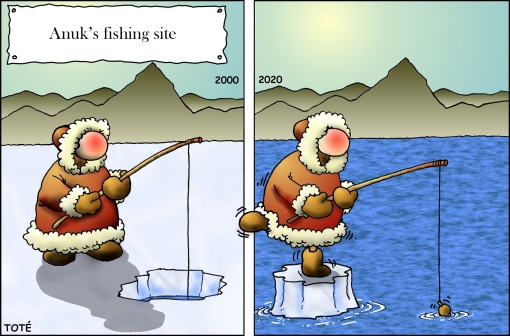Both the uncertainty inherent in scientific data, and the honesty of those scientists who report such data to any given audience, can sow doubt about the science of climate change. The perception of this duality is engrained in how the human mind works. We illustrate this through a personal experience connecting with global environmentalism, and synthesise some guidelines to communicate the science of climate disruption by humans.

Courtesy of Toté (www.elcomic.es)
In January 2017, the Spanish environmental magazine Quercus invited us to give a talk, at the Cabinet of Natural History in Madrid, about our article on the effects of climate change on the feeding ecology of polar bears, which made to Quercus’ cover in February 2017 (1) — see blog post here. During questions and debate with the audience (comprising both scientists and non-scientists), we displayed a graph illustrating combinations of seven sources of energy (coal, water, gas, nuclear, biomass, sun and wind) necessary to meet human society’s global energy needs according to Barry Brook & Corey Bradshaw (2). That paper supports the idea that nuclear energy, and to a lesser extent wind energy, offer the best cost-benefit ratios for the conservation of biodiversity after accounting for factors intimately related to energy production, such as land use, waste and climate change.
While discussing this scientific result, one member of the audience made the blunt statement that it was normal that a couple of Australian researchers supported nuclear energy since Australia hosts the largest uranium reservoirs worldwide (~1/3 of the total). The collective membership of Quercus and the Cabinet of Natural History is not suspicious of lack of awareness of environmental problems, but a different matter is that individuals can of course evaluate a piece of information through his/her own and legitimate perspective.
The stigma of hypocrisy
Indeed, when we humans receive and assimilate a piece of information, our (often not self-conscious) approach can range from focusing on the data being presented to questioning potential hidden agendas by the informer. However, the latter can lead to a psychological trap that has been assessed recently (3) — see simple-language summary of that assessment in The New York Times. In one of five experiments, a total of 451 respondents were asked to rank their opinion about four consecutive vignettes tracking the conversation between two hypothetical individuals (Becky & Amanda) who had a common friend. During this conversation, Amanda states that their friend is pirating music from the Internet, and Becky (who also illegally downloads music) can hypothetically give three alternative answers: Read the rest of this entry »



